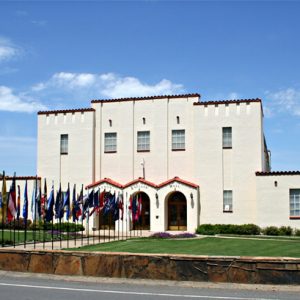calsfoundation@cals.org
Arkansas National Guard Museum
The Arkansas National Guard Museum’s primary mission is to collect information and artifacts relating to the Arkansas National Guard and its militia predecessor and make that information and those artifacts available to the public and to posterity. In addition, the museum tells the story of Camp Pike/Camp Robinson. It is located in Lloyd England Hall on Camp Robinson in North Little Rock (Pulaski County). Lloyd England Hall, originally constructed in 1931, is on the National Register of Historic Places.
There has been a museum in Lloyd England Hall since the mid-1970s. The hall was constructed in 1932 as a multi-purpose center with a reading room, writing room, and large area with a stage and a balcony that held a movie projector. It was converted to a movie theater in World War II and served as such until the mid-1960s. It was then used as an auditorium until leaks forced most of the building to be closed in the early 1990s. The museum, housed in one 750-square-foot room, consisted of a 200-piece weapon collection and a few artifacts and photographs. No full-time personnel were assigned to the museum, and it was open by appointment only.
In January 1989, a not-for-profit corporation was established with a goal of establishing a worthy museum for the Arkansas National Guard. The original incorporators were Oscar Russell, Steve Rucker, Stan Peebles, Jim Pollnow, and Douglas House. The incorporators immediately began to raise money, focusing on current and retired Guard members.
With the support of Adjutants General Jack Ryan, Mel Thrash, and Don Morrow, the corporation raised a little over $300,000 by 1998. In that same year, the state legislature approved funding for a museum director, and Steve Rucker was hired to fill that position.
During the summer of 1998, the existing museum artifacts were packed and placed in storage, and plans were completed for a renovation of 6,500 square feet of Lloyd England Hall for exhibit space, including humidity control and 800 square feet of office space. The remaining 4,800 square feet were not to be remodeled but were to be air-conditioned storage space.
Construction began in October 1998 and was completed in June 1999. Construction costs totaled just under $300,000. In addition to renovating the interior space, the existing aluminum store-front-type doors were removed, and three sets of oak double doors with arched transoms were built on site to replicate the originals. After exhibits were set up during the summer, the museum opened on September 11, 1999.
The museum has received five grants from the Arkansas Natural and Cultural Resource Council. Two were used for additional work to restore the exterior of Lloyd England Hall to its original appearance. One was for the conservation of a Confederate Civil War battle flag captured at the Engagement at Jenkins’ Ferry. The other two grants were for construction of 1:1,000 scale models of Camp Pike circa 1918 (9’x18′) and Camp Robinson circa 1943 (10’x20′).
In October 2006, the museum remodeled all of the remaining space in the museum, this time with money provided by the federal government. Of the 4,800 square feet originally intended for storage, 1,200 square feet were added to the exhibit space, bringing the total exhibit space to 7,700 square feet. The remaining 3,600 square feet of storage space were remodeled, and humidity control was installed.
The exhibits consist of text panels and pictures, augmented by scale models, in the two rooms devoted to the history of Camp Pike/Camp Robinson. In the three rooms devoted to the history of the Arkansas National Guard, the panels are augmented with uniforms, weapons, and other military equipment. The last room in the museum has a large weapon display as well as two jeeps, an artillery piece with limber and caisson, and a large commemorative pillowcase display on Camp Robinson from World War II.
The Arkansas National Guard Museum attracted attention in February 2025 after it was revealed that the museum, in compliance with guidance issued by Secretary of Defense Pete Hegseth, canceled a planned Black History Month event that had been organized in partnership with the Mosaic Templars Cultural Center.
For additional information:
Arkansas National Guard Museum. http://www.arngmuseum.com/ (accessed January 18, 2023).
Green, Andrew M. “Old Camp Robinson Goes on Display.” Arkansas Democrat-Gazette, September 12, 1999, pp. 1B, 3B.
Strain, Milo. “Trump Administration Directive Scuttles Black History Month at Arkansas National Guard Museum.” Arkansas Times, February 13, 2025. https://arktimes.com/arkansas-blog/2025/02/13/trump-administration-directive-scuttles-black-history-month-event-at-arkansas-national-guard-museum (accessed February 14, 2025).
Steve Rucker
Little Rock, Arkansas
 Arkansas National Guard Museum
Arkansas National Guard Museum 



Comments
No comments on this entry yet.